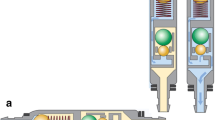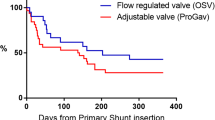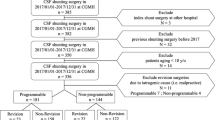Abstract
Purpose
Hydrocephalus is one of the most common pathologies in pediatric neurosurgery. One of the causes of recurring events of headaches among shunted children is “slit ventricle syndrome” (SVS). Several potential treatments have been proposed, yet SVS often represents a treatment challenge. The goal of the current series is to present our experience with adding a positional shunt-assist (SA) (Miethke, Aesculap) for the treatment of SVS.
Methods
Clinical data was retrospectively collected from all consecutive children with SVS that were treated with SA (Miethke, Aesculap) at our center. Surgical and clinical outcomes as expressed by hospital visits, or need for additional surgery, were evaluated.
Results
Nine cases were included. Hydrocephalus etiology included IVH (6), postinfectious (1), and congenital syndromes (2). Average age at first shunt was 4 months. Primary shunt type was differential-pressure-valve in all. Average age at SVS onset was 4 years. Average age at SA placement was 5.5 years. There were no perioperative complications besides a single stich abscess. A 6-month follow-up period after SA was compared to a 6-month period prior to the SA: average hospital visits decreased from 2.4 to 0.6 per patient (p < 0.0002). 4/9 patients needed an LP or shunt revision before the SA surgery, while no procedure was indicated during the immediate 6-month follow-up. At the last follow-up, there was a significant reduction in the rate of ER visits compared to prior to surgery; however, the number of neurosurgical procedures did not significantly differ.
Conclusion
Using a SA for SVS was associated with a short-term improvement of symptoms in the majority of cases, reduction in hospital visits, and reduced need for SVS-related procedures.



Similar content being viewed by others
Availability of data and materials
The data that support the findings of this study are available on request from the corresponding author.
References
Panagopoulos D, Stranjalis G, Gavra M, Boviatsis E, Korfias S (2022) Shunt over-drainage, slit ventricle syndrome, programmable valves and anti-siphon devices. A narrative review of a multifactorial and intractable problem. J Integr Neurosci 21(3):84. https://doi.org/10.31083/j.jin2103084
Stellman-Ward G, Bannister C, Lewis M, Shaw J (1997) The incidence of chronic headache in children with shunted hydrocephalus. Euro J Pediat Surg 7(S1):12–14. https://doi.org/10.1055/s-2008-1071201
Panagopoulos D, Karydakis P, Themistocleous M (2021) Slit ventricle syndrome: historical considerations, diagnosis, pathophysiology, and treatment review. Brain Circ 7(3):167. https://doi.org/10.4103/bc.bc_29_21
Kraemer MR, Sandoval-Garcia C, Bragg T, Iskandar BJ (2017) Shunt-dependent hydrocephalus: management style among members of the American Society of Pediatric Neurosurgeons. J Neurosurg Pediatr 20(3):216–224. https://doi.org/10.3171/2017.2.PEDS16265
Beez T, Munoz-Bendix C, Ahmadi SA, Messing-Jünger M, Steiger HJ, Röhrig A (2019) Conservative and operative management of iatrogenic craniocerebral disproportion—a case-based review. Child’s Nervous System 35(1):19–27. https://doi.org/10.1007/s00381-018-3981-9
Jain H, Sgouros S, Walsh AR, Hockley AD (2000) The treatment of infantile hydrocephalus: “differential-pressure” or ”flow-control” valves. Child’s Nervous System 16(4):242–246. https://doi.org/10.1007/s003810050505
Davis SE, Levy ML, McComb JG, Sposto R (2000) The delta valve: how does its clinical performance compare with two other pressure differential valves without antisiphon control? Pediatr Neurosurg 33(2):58–63. https://doi.org/10.1159/000028988
Freimann FB, Sprung C (2012) Shunting with gravitational valves—can adjustments end the era of revisions for overdrainage-related events? J Neurosurg 117(6):1197–1204. https://doi.org/10.3171/2012.8.JNS1233
Park SW, Yoon SH, Cho KH, Shin YS (2007) Valve pressure upgrade may produce progressive deterioration of vision in children with slit ventricle syndrome. Pediatr Neurosurg 43(5):428–432. https://doi.org/10.1159/000106398
Rohde V, Mayfrank L, Ramakers VT, Gilsbach JM (1998) Four-year experience with the routine use of the programmable Hakim valve in the management of children with hydrocephalus. Acta Neurochir (Wien) 140(11):1127–1134. https://doi.org/10.1007/s007010050226
Chernov MF, Kamikawa S, Yamane F, Ishihara S, Hori T (2005) Neurofiberscope-guided management of slit-ventricle syndrome due to shunt placement. J Neurosurg Pediatr 102(3):260–267. https://doi.org/10.3171/ped.2005.102.3.0260
Benabarre A, Ibáñez J, Boget T, Obiols J, Martínez-Aran A, Vieta E (2001) Neuropsychological and psychiatric complications in endoscopic third ventriculostomy: a clinical case report. J Neurol Neurosurg Psychiatry 71(2):268–271. https://doi.org/10.1136/jnnp.71.2.268
Roth J, Biyani N, Udayakumaran S et al (2011) Modified bilateral subtemporal decompression for resistant slit ventricle syndrome. Child’s Nervous System 27(1):101–110. https://doi.org/10.1007/s00381-010-1220-0
Rekate HL (2004) The slit ventricle syndrome: advances based on technology and understanding. Pediatr Neurosurg 40(6):259–263. https://doi.org/10.1159/000083737
Gutowski P, Gölz L, Rot S, Lemcke J, Thomale UW (2020) Gravitational shunt valves in hydrocephalus to challenge the sequelae of over-drainage. Expert Rev Med Devices 17(11):1155–1168. https://doi.org/10.1080/17434440.2020.1837622
Fattal-Valevski A, Beni-Adani L, Constantini S (2005) Short-term dexamethasone treatment for symptomatic slit ventricle syndrome. Child’s Nervous System 21(11):981–984. https://doi.org/10.1007/s00381-004-1132-y
Ros B, Iglesias S, Martín Á, Carrasco A, Ibáñez G, Arráez MA (2018) Shunt overdrainage syndrome: review of the literature. Neurosurg Rev 41(4):969–981. https://doi.org/10.1007/s10143-017-0849-5
Rekate HL (2008) Shunt-related headaches: the slit ventricle syndromes. Child’s Nervous System 24(4):423–430. https://doi.org/10.1007/s00381-008-0579-7
Alavi S, Schulz M, Schaumann A, Schwarz K, Thomale UW (2017) Valve exchange towards an adjustable differential pressure valve with gravitational unit, clinical outcome of a single-center study. Child’s Nervous System 33(5):759–765. https://doi.org/10.1007/s00381-017-3387-0
Acknowledgements
We thank Mrs. Adina Sherer for editorial assistance and Moran Artzi and Tomer Ziv-Baran for their contribution to the statistical analysis.
Author information
Authors and Affiliations
Contributions
Conception and design: Roth and Constantini S. Acquisition of data: Azolai and Constantini L. Analysis and interpretation of data: Azolai and Roth. Drafting the article: Azolai and Roth. Critically revising the article: all authors. Review of the submitted version of the manuscript: all authors. Approval of the final version of the manuscript on behalf of all authors: Roth. Study supervision: Roth.
Corresponding author
Ethics declarations
Ethics approval
This study was approved by Helsinki Committee (0198–22-TLV).
Conflict of interest
The authors report no competing of interest concerning the materials or methods used in this study or the findings specified in this paper.
Additional information
Publisher's Note
Springer Nature remains neutral with regard to jurisdictional claims in published maps and institutional affiliations.
Rights and permissions
Springer Nature or its licensor (e.g. a society or other partner) holds exclusive rights to this article under a publishing agreement with the author(s) or other rightsholder(s); author self-archiving of the accepted manuscript version of this article is solely governed by the terms of such publishing agreement and applicable law.
About this article
Cite this article
Azolai, L., Constantini, S., Constantini, L. et al. Positional shunt assist for slit ventricle syndrome. Childs Nerv Syst 40, 109–114 (2024). https://doi.org/10.1007/s00381-023-06145-2
Received:
Accepted:
Published:
Issue Date:
DOI: https://doi.org/10.1007/s00381-023-06145-2




